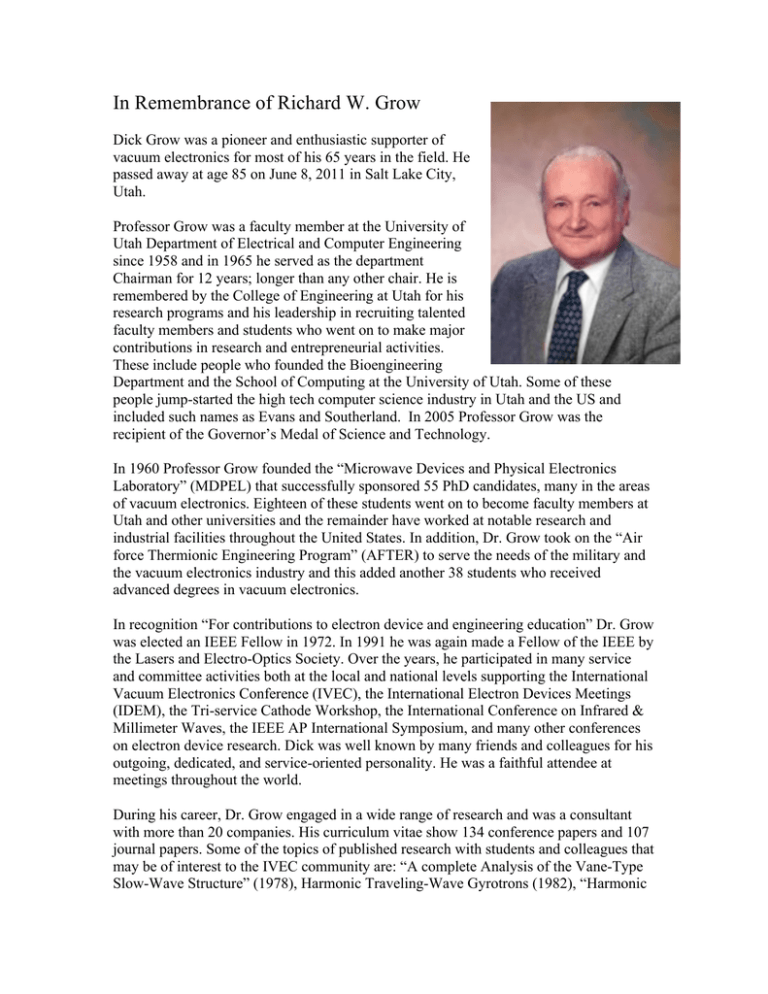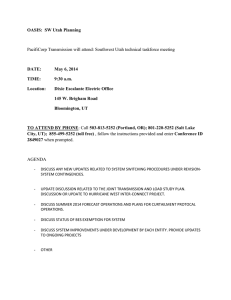In Remembrance of Richard W. Grow
advertisement

In Remembrance of Richard W. Grow Dick Grow was a pioneer and enthusiastic supporter of vacuum electronics for most of his 65 years in the field. He passed away at age 85 on June 8, 2011 in Salt Lake City, Utah. Professor Grow was a faculty member at the University of Utah Department of Electrical and Computer Engineering since 1958 and in 1965 he served as the department Chairman for 12 years; longer than any other chair. He is remembered by the College of Engineering at Utah for his research programs and his leadership in recruiting talented faculty members and students who went on to make major contributions in research and entrepreneurial activities. These include people who founded the Bioengineering Department and the School of Computing at the University of Utah. Some of these people jump-started the high tech computer science industry in Utah and the US and included such names as Evans and Southerland. In 2005 Professor Grow was the recipient of the Governor’s Medal of Science and Technology. In 1960 Professor Grow founded the “Microwave Devices and Physical Electronics Laboratory” (MDPEL) that successfully sponsored 55 PhD candidates, many in the areas of vacuum electronics. Eighteen of these students went on to become faculty members at Utah and other universities and the remainder have worked at notable research and industrial facilities throughout the United States. In addition, Dr. Grow took on the “Air force Thermionic Engineering Program” (AFTER) to serve the needs of the military and the vacuum electronics industry and this added another 38 students who received advanced degrees in vacuum electronics. In recognition “For contributions to electron device and engineering education” Dr. Grow was elected an IEEE Fellow in 1972. In 1991 he was again made a Fellow of the IEEE by the Lasers and Electro-Optics Society. Over the years, he participated in many service and committee activities both at the local and national levels supporting the International Vacuum Electronics Conference (IVEC), the International Electron Devices Meetings (IDEM), the Tri-service Cathode Workshop, the International Conference on Infrared & Millimeter Waves, the IEEE AP International Symposium, and many other conferences on electron device research. Dick was well known by many friends and colleagues for his outgoing, dedicated, and service-oriented personality. He was a faithful attendee at meetings throughout the world. During his career, Dr. Grow engaged in a wide range of research and was a consultant with more than 20 companies. His curriculum vitae show 134 conference papers and 107 journal papers. Some of the topics of published research with students and colleagues that may be of interest to the IVEC community are: “A complete Analysis of the Vane-Type Slow-Wave Structure” (1978), Harmonic Traveling-Wave Gyrotrons (1982), “Harmonic Gyrotron Interactions” (1983), “Gyrotron and Peniotron Modes in Rotating-Beam Devices” (1984), “Fourth Harmonic Gyrotron Development” (1984), “SubmillimeterWave BWO’s” (1985), “650 GHz O-type BWO” (1987), “Harmonic Auto-Resonant Piniotron” (1987), “Microfabricated Sub-mm BWO Experiments” (1988). As a graduate student at Stanford University, Dick’s first major contribution to vacuum electronics was a dissertation entitled “Backward-Wave Oscillator Efficiency” and his interest in education and in microwave vacuum tubes never waned. He still taught a section of his microwave tube course during the Spring Semester of 2011 and he also attended his 52nd consecutive commencement exercise. The university and the research community will miss his remarkable dedication. He leaves behind the reputation and memory of a great man, who was honorable, accomplished, respected, and loved. J. Mark Baird (Retired) ECE, Univ. Utah July 2011





